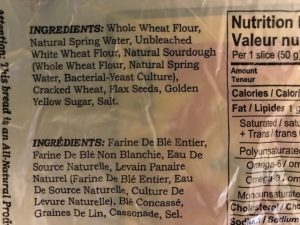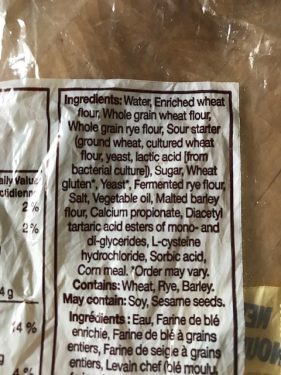What’s a real sourdough? How do you know? What do you need to look for? By the end of this short blog post, you will have the answers to all of these questions!
We’re picking up the thread that Jon Ungoed-Thomas started about six weeks ago with his article in The Guardian (April 23, 2022): “An honest crust? Craft bakeries rise up against “sourfaux” bread“. This article struck a chord with us because we’ve had our own frustrations about labelling here in Canada.
Even my sweet husband was duped just a few weeks ago when he thought he was bringing home a treat for me. He had bought me “sourdough” bagels. But…
It turns out there are a lot of ways to fake sourdough and mislead consumers when there aren’t strict labeling laws.
What makes a sourdough real?
We’ve written a lot about this many times before. The key ingredient to a real sourdough is having a live bacterial culture. The bacteria are the heart of the sourdough. They are the reason why fermented products like ours provide nutritional benefits that other products don’t. They contribute to the great flavour and to making sourdough products keep longer.
The bacteria also help to break down different components in the grains and seeds. This makes them more easy for us to absorb during digestion. It’s also why overall, they are easier to digest. The bacteria help make that part easier for our digestive systems, too.
With our sourdough pastas, we’ve also noticed a few other great characteristics. The digestive and nutritional benefits are there. But there’s a structural change that we didn’t initially expect. Compared to conventional (non-fermented) pastas, ours cooks faster! The bacteria help to break down the proteins in the grains so our dried noodles take less time to cook. Cool, right?

What’s in Kaslo Sourdough?
Our products all use our unique Kaslo Sourdough bacterial culture. We use the same bacterial culture in our sourdough pastas!
And the ingredients are always straight forward: the flours or grains, natural spring water, the sourdough bacterial culture, and in our sourdough breads, a bit of golden sugar and salt. That’s it! Using fermentation technology from the past, we make high quality sourdough breads and pastas that you can feel good about sharing with friends and family.
A quick dive into labelling laws in Canada
We’ll be quick with this part, we promise (this stuff can be dry; we get it). In Canada, food labeling laws are managed by the Canadian Food Inspection Agency (CFIA). The CFIA develops guidance for businesses in the food production industry that need to be followed by anyone putting a new product on the market. Ultimately, this is a good thing. It means that companies can’t just create a product and claim it can cure something or make you live longer when they really don’t do that. There are rules about the types of things that can go on a label.
The current CFIA guidance for “grain and bakery products“, however, doesn’t include any regulations for “sourdough”, which we see as a gap. It means that anyone who can figure out how to mimic sourdough can call it that and get away with it. It’s the same problem highlighted in the Guardian article.

So how can you tell you have the real deal?
Here’s the part you really need to know. When you are standing in the grocery store holding a product that has “sourdough” in the name or on the label, just check the ingredients list and see if “bacterial culture” is there. Or, even better, see if some kind of specific bacteria from the Lactobascilli family. Lactobacilli are the most common bacteria used in fermented bread products.
If the product doesn’t have a bacterial culture listed, it’s not a real sourdough. Simple as that. Some companies might try to get sneaky and list things that look like they are sourdough, but really aren’t. And there ARE a lot of things can make a “sour” flavour that people typically associate with a San Francisco sourdough. But many people are surprised by our products. As you likely know, they don’t taste sour. The bacteria bring out the flavours of the grains.
Now that you know this key aspect, you’ll be able to both identify the real thing and not spend money on any fakes ones in the future!
Back to news


